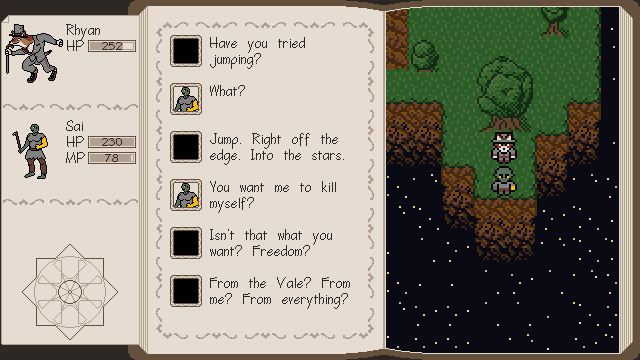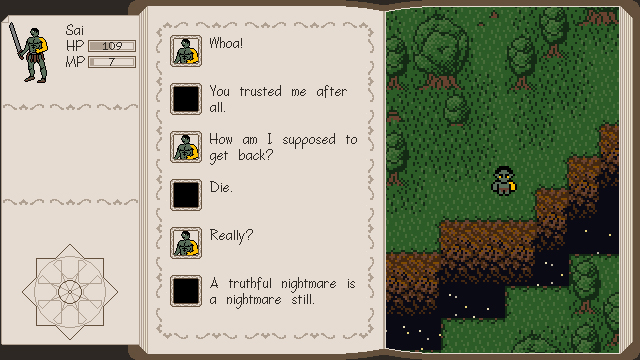Shadow of Depression
The original drafts of Dawnshadow didn't have a story. It was Sai alone in the Shadowed Vale, trying to get away from Syn. Coatl-ome, a fellow prisoner, was there with him and would make equipment for him. The other gods showed up on occasion to move the story. But it it was mostly Sai and Syn.

There is a lot of history between Sai and his tormentor, most of which is only referenced in passing during the course of Dawnshadow. All the player essentially knows is that Syn, the Eternal Nightmare, god of darkness and destruction, helped Sai get ahead in life and locked him within its nightmarish domain in return. This serves as the foundation for their entire relationship, which I then have to express through scattered lines of dialogue that the player frequently encounters out of order.
The conversations between Sai and Syn were some of the easiest to write in all of Dawnshadow. Each of them has a very clear goal (to me; Syn's goals might be a bit murkier to the player) and knows exactly what they need to do to reach it. Syn's smug superiority is always met by Sai's relentless determination with Syn almost universally ending up on top. Their verbal sparring is also distinct from the sniping that goes on between Sai and Coatl-ome, who also dislikes Sai. The fellow prisoners often engage in mutual gallows humor, but the conversations between Sai and Syn are characteristically dark. And depressing.

I've lived with depression since college. Probably before, but that's when I ended up on meds and in therapy. I don't say "struggled," because it's not really. I don't need antidepressants now and can always get out of bed, get to work, care for my daughter. But it is something that I live with. Like the arthritis slowly destroying my spine, it is always there. Some days just hurt less than others.
There is an extent to which Dawnshadow is a story about depression. A story about one orc's struggle to be free from the darkness. This is something that happens, that is inescapable in the creation of art. Something of the creator gets trapped in there whether we like it or not. If only we could choose which bits! And if only they stayed there, cast out and locked away. But they do not. They remain preserved forever, something we and our audience must confront and, hopefully, learn from.

As such, it was important to me that Syn always told the truth. Never once does the voice in the darkness lie to Sai. On the one hand, it doesn't need to. To resort to a lie is to abdicate one's own power at best or to admit that one's power is illusory at worst. Syn holds all the cards; it has no need for lies. On the other hand, what good would lies do it? If it's going to whisper to Sai about all his own regrets and failings, lies will be detected and discarded very quickly. The voices in the dark don't lie; it is the victims who lie to themselves to keep that voice at bay.
So this got dark. Which is okay. Dawnshadow deals with dark subject matter, and its story unfolds largely organically as the player explores and experiments and grows. That growth along the journey is important, since Dawnshadow's end is effectively preordained. The game has two primary endings with significant variations in one, but that one is a far more likely outcome than the other. Like I said before, Syn holds all the cards. So what Sai does on his way to that final encounter with the Eternal Nightmare becomes much more important than what happens once he gets there.
The Syn of Serinor is complex and dynamic, both callously destructive and deeply creative. I don't know if all those facets were captured within the compressed pages of Dawnshadow, but I think the Eternal Nightmare turned out to be a compelling villain regardless.
See you in the dark of the solstice.
Get Epic of Serinor: Dawnshadow
Epic of Serinor: Dawnshadow
| Status | Released |
| Author | eldritch05 |
| Genre | Role Playing |
| Tags | 2D, 8-Bit, Open World, Pixel Art, Singleplayer, Story Rich |
| Languages | English |
More posts
- Tutorial UpdateJan 30, 2019
- Day One PatchDec 22, 2018
- The Dawnshadow ArrivesDec 21, 2018
- The Underlying IssueDec 21, 2018
- The Dawnshadow ApproachesDec 15, 2018
- People in an Empty ValeDec 06, 2018
- The Age of the DawnshadowDec 06, 2018
Leave a comment
Log in with itch.io to leave a comment.